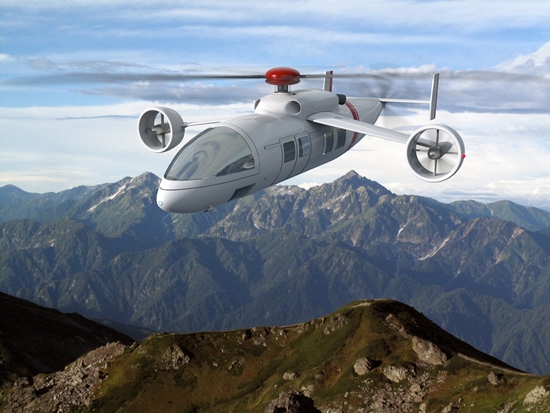Research & Development
JAXA promotes three research and development programs and a fundamental research program that underpins them.
High-speed rotary aircraft technology
- April 4, 2023
- A flight test for optimal high-mu rotor conducted[JAXA Activity Report July 2022 - March 2023]
- June 16, 2022
- High-speed helicopters that fly twice as fast as conventional rotorcraft [JAXA's No 87]
- January 29, 2020
- High-speed rotary wing aircraft [FLIGHT PATH No.24 | 2019 Winter]
In addition to aircraft which use rotary airfoils as their primary means of propulsion and lifting, various types rotary airfoil airplanes, typically represented by helicopters, are being studied: tilt-rotors use a fixed wing for primary lift generation during horizontal flight; compound helicopters use a fixed wing and a propeller to provide lift/propulsion force during forward flight. Some such aircraft are already in practical use.
In Japan, this type of aircraft can be extremely useful for disaster relief, mountain rescue efforts, and for emergency transportation from isolated islands. To present the conceptual design idea of a compound helicopter suited to these needs, we are striving to accumulate basic design technology of future rotary-wing airplanes and to perform pioneering technical development ahead of domestic manufacturers. Through these efforts, we will play a pioneering role in the development of future rotary-wing airplanes, eventually transferring the acquired technology to private sector manufacturers. In this regard, we will be promoting the creation of new markets and industries through the development of new models by manufacturers.
The following technical tasks are necessary to investigate the conceptual design of a new form of aircraft.
- Proposal of a concept of a future type of rotary-wing airplane suited for Japan, based on comparison and investigation of various forms of rotary-wing aircraft.
- Determination of specifications meeting the requirements of future type rotary-wing missions and the calculation of performance to confirm successful flight.
- Construction of various design tools for the optimum design of the aerodynamic configuration of rotary-wing aircraft based on CFD technology.
After these technical tasks are completed, it will be possible to produce concept designs for future rotary-wing aircraft which provide excellent safety, low noise, and flight performance that is far superior to that of a conventional helicopter.
Furthermore, we will promote the research and development for sophistication of CFD technology that enables analysis of complicated wake flows corresponding to future rotary-wing aircraft, reduction of aerodynamic resistance and noise, and steering technology to be provided in the blade, which will contribute greatly to flight safety and ease of maintenance.
Specifically, we are investigating a new type of compound helicopter with no tail rotor, unlike an ordinary helicopter, and to which are added fixed wings and propellers. Drastic improvement (about 1.8 times) of the maximum flying speed can be expected with excellent hovering performance. Although efficiency at high-speed forward flight is inferior to that of conventional tilt-rotor aircraft, hovering performance is maintained and instability at the transition mode can be avoided. Consequently, high mission capability and safety can be secured.

JAXA Compound Helicopter